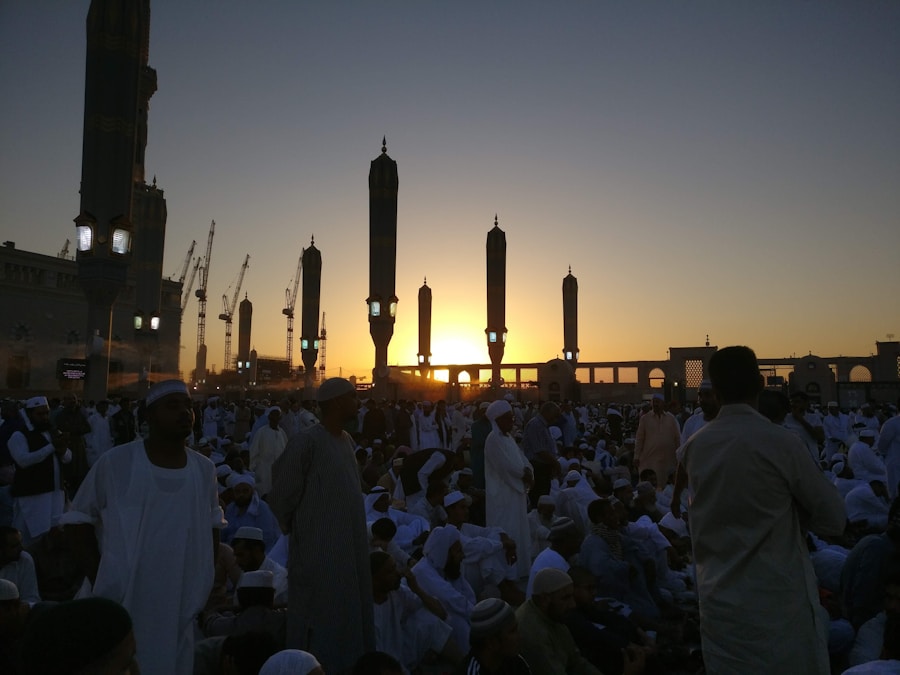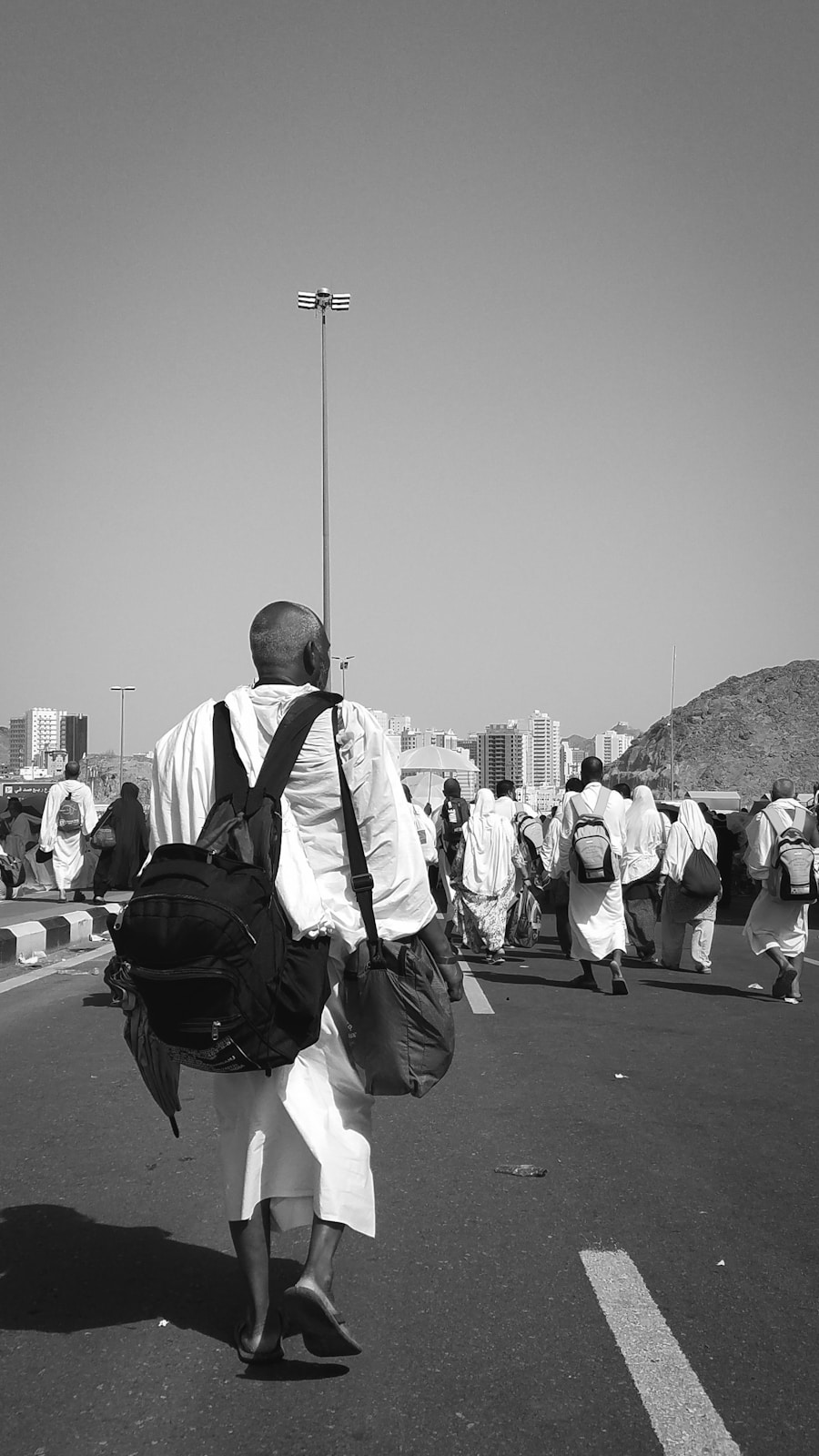The origins of Hajj and Umrah are deeply rooted in Islamic tradition and history, tracing back to the time of the Prophet Ibrahim (Abraham) and his family. According to Islamic belief, Ibrahim was commanded by God to leave his wife Hagar and their infant son Isma’il (Ishmael) in the barren valley of Mecca. In her desperate search for water, Hagar ran seven times between the hills of Safa and Marwah, a journey that symbolizes the trials faced by a mother.
This act of perseverance is commemorated during the rituals of Hajj and Umrah, where pilgrims replicate Hagar’s search for sustenance. The well of Zamzam, which miraculously sprang forth to quench their thirst, further solidified Mecca’s significance as a sacred site. The Kaaba, a cube-shaped structure located in the heart of Mecca, is believed to have been built by Ibrahim and Isma’il as a house of worship dedicated to the One God.
Over centuries, the Kaaba became a focal point for worship and pilgrimage, attracting followers from various tribes and regions. The establishment of Hajj as a formal pilgrimage was solidified in 630 CE when the Prophet Muhammad returned to Mecca after years of exile. He performed the pilgrimage and established its rituals, emphasizing its importance as an act of devotion and submission to God.
The Quran explicitly mentions Hajj in Surah Al-Baqarah, highlighting its significance as a divine command for those who are physically and financially able to undertake the journey.
Key Takeaways
- Hajj and Umrah have their origins in the Islamic history and are deeply rooted in the faith and traditions of Islam.
- The significance of Hajj and Umrah is highlighted in the Five Pillars of Islam, emphasizing their importance in the life of a Muslim.
- The rituals and practices of Hajj and Umrah are deeply symbolic and hold great spiritual significance for the pilgrims.
- The historical significance of Hajj and Umrah in Islam dates back to the time of Prophet Ibrahim and his family, making it a deeply revered tradition.
- Hajj and Umrah hold great importance in the life of a Muslim, serving as a spiritual journey and a means of seeking forgiveness and blessings from Allah.
The Five Pillars of Islam and the significance of Hajj and Umrah
The Five Pillars of Islam
Hajj and Umrah hold a prominent place within the framework of the Five Pillars of Islam, which serve as the foundational acts of worship for Muslims.
The Significance of Hajj and Umrah
The significance of these two pilgrimages extends beyond mere ritual; they embody the essence of Islamic faith and community. Hajj is performed during the Islamic month of Dhu al-Hijjah and involves a series of specific rituals that commemorate the actions of Ibrahim and his family. It serves as a unifying force for Muslims worldwide, as millions gather in Mecca to perform the pilgrimage together, transcending cultural and national boundaries.
The Spiritual Value of Umrah
This collective experience fosters a sense of belonging and solidarity among Muslims, reinforcing their shared identity as followers of Islam. In contrast, Umrah, often referred to as the “lesser pilgrimage,” can be undertaken at any time and involves fewer rituals. While it is not obligatory, it holds immense spiritual value, allowing Muslims to seek forgiveness and draw closer to God.
The rituals and practices of Hajj and Umrah

The rituals associated with Hajj are meticulously outlined and steeped in historical significance. The pilgrimage begins with the state of Ihram, a sacred condition that pilgrims enter by donning simple white garments—two unstitched cloths for men and modest attire for women. This state symbolizes purity, equality, and humility before God.
Pilgrims then proceed to perform Tawaf, which involves circling the Kaaba seven times in a counterclockwise direction while reciting prayers. This act signifies the unity of believers in the worship of the One God. Following Tawaf, pilgrims engage in Sa’i, retracing Hagar’s footsteps between the hills of Safa and Marwah seven times.
This ritual serves as a reminder of faith, resilience, and divine mercy. The culmination of Hajj occurs on the Day of Arafah, where pilgrims gather at the plain of Arafat to engage in supplication and reflection. This day is considered one of the most significant moments in a Muslim’s life, as it is believed that sincere prayers are answered.
The subsequent days involve additional rituals such as Eid al-Adha celebrations, where pilgrims sacrifice an animal in remembrance of Ibrahim’s willingness to sacrifice his son in obedience to God. Umrah, while less complex than Hajj, also encompasses essential rituals that hold deep spiritual meaning. Pilgrims begin by entering Ihram and performing Tawaf around the Kaaba, followed by Sa’i between Safa and Marwah.
Unlike Hajj, Umrah does not require specific dates or extensive rituals; it can be performed at any time throughout the year. Many Muslims choose to undertake Umrah during Ramadan due to its heightened spiritual significance during this holy month.
The historical significance of Hajj and Umrah in Islam
The historical significance of Hajj and Umrah extends beyond their religious dimensions; they have played pivotal roles in shaping Islamic civilization and culture throughout history. The pilgrimage has served as a catalyst for trade, cultural exchange, and intellectual discourse among diverse Muslim communities. Historically, Mecca was not only a religious center but also a bustling hub for commerce where merchants from various regions converged during the pilgrimage season.
This interaction facilitated the exchange of goods, ideas, and knowledge across different cultures. Moreover, Hajj has been instrumental in fostering unity among Muslims across geographical boundaries. Throughout history, leaders such as Caliph Umar ibn al-Khattab emphasized the importance of pilgrimage as a means to strengthen communal ties among Muslims.
The annual gathering at Mecca has provided an opportunity for Muslims from different backgrounds to come together in worship, reinforcing their shared beliefs and values. This sense of unity has been particularly significant during times of political strife or social upheaval within the Muslim world.
The importance of Hajj and Umrah in the life of a Muslim
For many Muslims, Hajj represents a lifelong aspiration—a spiritual journey that embodies their devotion to God. The pilgrimage is often viewed as a transformative experience that allows individuals to seek forgiveness for past sins and renew their commitment to their faith. The emotional impact of standing before the Kaaba, surrounded by fellow believers from around the world, can be profound.
Many pilgrims describe feelings of humility, gratitude, and an overwhelming sense of connection to their faith during this sacred journey. Umrah also holds significant importance in the lives of Muslims who may not have the means or ability to perform Hajj. It provides an opportunity for spiritual rejuvenation and reflection without the extensive requirements associated with Hajj.
Many Muslims undertake Umrah multiple times throughout their lives as a means to seek closeness to God and engage in acts of worship outside the obligatory framework. Both pilgrimages serve as reminders of the transient nature of life and the importance of prioritizing one’s relationship with God.
The impact of Hajj and Umrah on the global Muslim community

The impact of Hajj and Umrah on the global Muslim community is multifaceted, influencing not only individual lives but also broader societal dynamics. The annual influx of millions of pilgrims to Mecca creates a unique environment where diverse cultures converge in worship. This gathering fosters intercultural dialogue and understanding among Muslims from various backgrounds, promoting a sense of global unity within the ummah (Muslim community).
Pilgrims return home with renewed faith and often share their experiences with their local communities, inspiring others to deepen their spiritual practices. Furthermore, Hajj serves as a powerful reminder of social equality among Muslims. Regardless of socioeconomic status or nationality, all pilgrims don the same simple attire during Hajj, symbolizing their equal standing before God.
This experience challenges societal hierarchies and encourages believers to reflect on issues such as poverty, injustice, and compassion towards others. The collective experience during Hajj reinforces values such as charity and community service, motivating many pilgrims to engage in philanthropic efforts upon their return home.
The economic and social impact of Hajj and Umrah on the host countries
The economic implications of Hajj and Umrah are significant for host countries like Saudi Arabia, where these pilgrimages are central to national identity and economy. Each year, millions flock to Mecca for Hajj alone, generating substantial revenue through various sectors such as hospitality, transportation, retail, and tourism services. Hotels are often fully booked months in advance, while local businesses thrive on the influx of pilgrims seeking food, souvenirs, and religious artifacts.
The Saudi government invests heavily in infrastructure development to accommodate this surge in visitors, enhancing facilities such as airports, roads, and public transportation systems. Socially, hosting millions of pilgrims fosters cultural exchange between local communities and international visitors. Saudi Arabia has made efforts to promote cultural understanding through initiatives that showcase its heritage while respecting diverse traditions brought by pilgrims from around the world.
However, this rapid influx also presents challenges related to crowd management, public health concerns, and environmental sustainability. Balancing economic benefits with social responsibilities remains an ongoing challenge for host countries as they strive to provide safe and meaningful experiences for pilgrims.
The future of Hajj and Umrah in the modern world
As we look toward the future of Hajj and Umrah in an increasingly interconnected world, several trends are emerging that may shape these pilgrimages’ evolution. Technological advancements have already begun transforming how pilgrims plan their journeys—from online booking systems for flights and accommodations to mobile applications that provide real-time information about rituals and crowd management during peak times. These innovations aim to enhance convenience while ensuring safety for millions undertaking this sacred journey.
Moreover, discussions surrounding sustainability are becoming increasingly relevant within the context of Hajj and Umrah. As environmental concerns grow globally, there is a pressing need for host countries to implement eco-friendly practices that minimize waste generation during pilgrimages while preserving cultural heritage sites. Initiatives such as promoting public transportation options or encouraging responsible tourism practices can contribute positively toward sustainable pilgrimage experiences.
In conclusion, while Hajj remains an enduring pillar within Islamic tradition rooted in history and spirituality; its future will undoubtedly be shaped by contemporary challenges—ranging from technological advancements to environmental sustainability—requiring thoughtful consideration from both religious authorities and host nations alike.
If you are interested in learning more about the importance of travel in general, you may want to check out this article on the ultimate cheat sheet on travel. It provides valuable tips and insights on how to make the most out of your travel experiences. Traveling is not only a way to explore new places and cultures, but it also allows us to broaden our horizons and gain a deeper understanding of the world around us. Just like Hajj and Umrah are important spiritual journeys for Muslims, travel can also be a transformative experience for people of all backgrounds.
FAQs
What is Hajj and Umrah in Islam?
Hajj and Umrah are both pilgrimages that hold great significance in Islam. Hajj is the major pilgrimage that is obligatory for every able-bodied and financially capable Muslim to perform at least once in their lifetime, while Umrah is a lesser pilgrimage that is recommended but not obligatory.
What is the history of Hajj and Umrah in Islam?
Hajj and Umrah have their origins in the time of Prophet Ibrahim (Abraham) and his family. The rituals of Hajj and Umrah are based on the actions of Prophet Ibrahim, his wife Hajar, and his son Isma’il, as well as the actions of Prophet Muhammad during his lifetime.
What are the rituals of Hajj and Umrah?
The rituals of Hajj include Tawaf (circumambulation) of the Kaaba, Sa’i (walking) between the hills of Safa and Marwah, standing at Mount Arafat, and the symbolic stoning of the devil. Umrah involves performing Tawaf and Sa’i, but does not include the standing at Mount Arafat or the stoning of the devil.
Why are Hajj and Umrah important in Islam?
Hajj and Umrah are important in Islam because they are acts of worship that demonstrate the unity of the Muslim community, the submission to the will of Allah, and the remembrance of Prophet Ibrahim’s devotion and sacrifice. They also serve as a means of spiritual purification and renewal for the individual Muslim.



0 Comment